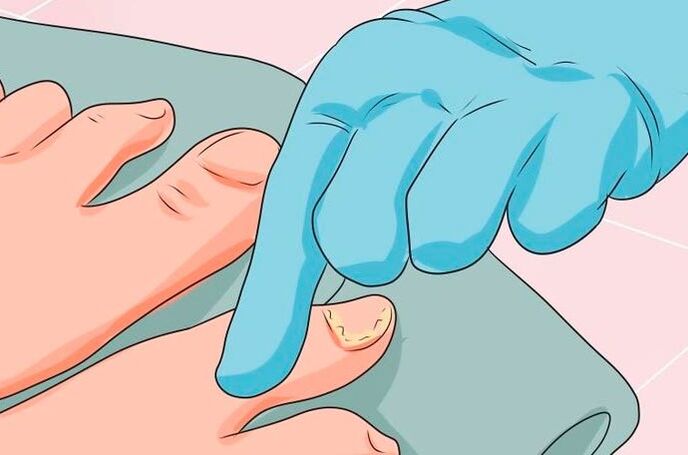
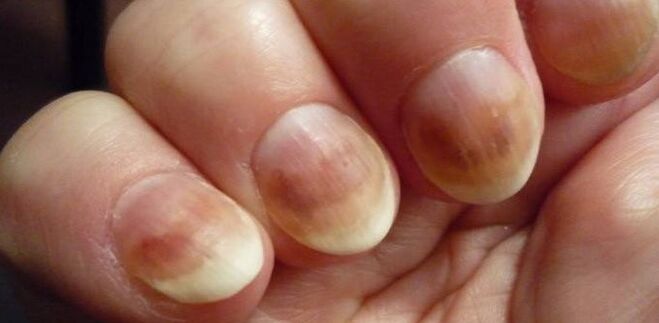
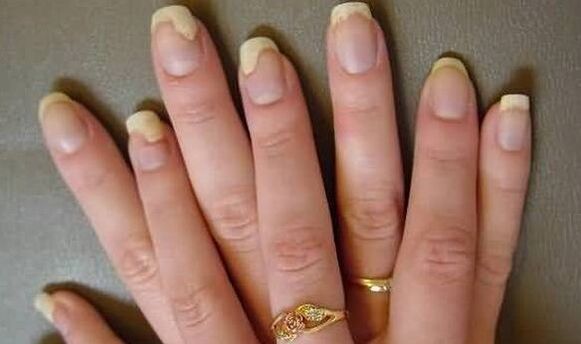
Folk remediesThere are many popular remedies that will help cure nails affected by a fungus at the initial stage. Consider simple effective recipes, but at the same time. Sometimes ordinary iodine can help quickly facing the fungusIodine - Every day until the symptoms disappear, apply 1 drop of iodine 5% to affected nails. The procedure is carried out in the morning, as well as in the evening. More equipment on the treatment of iodine.1 teaspoon of iodine, vinegar, glycerol is mixed and diluted with 6 teaspoons of water. The resulting mixture for 10 days in a row rubs the nails. The composition on the nail plate should be left overnight.Vinegar - Prepare a bath by diluting 1 part of vinegar 9% with 8 parts of lukewarm water. To hover in his legs or arms for 20 minutes. Perform 7 procedures every two days. More equipment on the treatment of vinegar.The egg ointment - Put a raw chicken egg in the shell in a glass and pour 9% vinegar at the top. When the shell dissolves, remove the remaining film and mix the egg with vinegar. The resulting mixture is applied twice a day to affected areas for 2 to 3 weeks.The chicken egg ointment is also quite effective against nail mycosis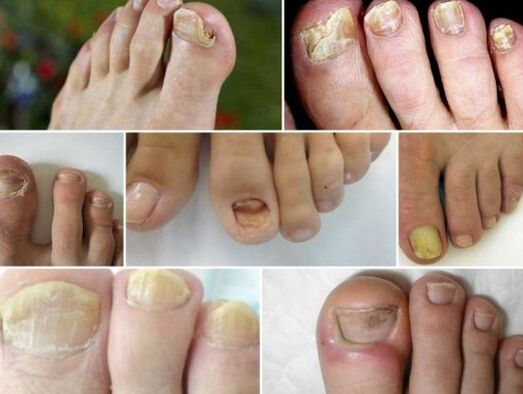
Hydrogen peroxide - Dilute in 2 liters of water 2 tablespoons of hydrogen peroxide 3%. Shared in hand or legs, depending on where the mushroom is located for 20 minutes. Repeat the procedure for 7 to 10 consecutive days.The peroxide compress-to impregnate a cotton-cottot with peroxide, attach it to the nails on which there are signs of the fungus. Before that, the arms or legs must be afraid in the soda bath. To prepare it, 1 teaspoon of soda is diluted in 1 liter of water. The compress on top is wrapped in cellophane or cling film and is left for 60 minutes. This is necessary for the peroxide to not evaporate. Repeat the procedure for 10 to 14 days twice a day.Propolis tincture - wet a cotton -cotton in 20% propolis alcohol dyeing and attach to the affected areas. Keep the lotion while the dry composition. Repeat daily until recovery. 1-2 The procedures are sufficient per day. Washing pump - The method is suitable for treatment of legs nails. It is necessary to dissolve 100 g of washing powder, which contains a lot of alkali, in 2 liters of water. Stay in such a bath for 15 minutes. Repeat 10-14 procedures while the symptoms disappear.Affel - Cut a blurred clove of garlic, wet in salt, then grate the plate. Repeat twice a day before the disappearance of symptoms.Ammonia - diluted in 1 glass of water 1 tablespoon of ammonia. The resulting solution is imbued with cotton fabric. It must wrap your legs or arms and leave this compress at night. Repeat the procedure for 7 days a day.Onions - Brinte the onion to the consistency of the porridge and set yourself with the nails affected for 30 minutes. Repeat twice a day before recovery.Hinsed onions will help turn your nails a healthy lookMix the chamomile, the wise mint, you can take dry or fresh herbs. Put the resulting composition in a toe or a glove at night. Herbs must be changed every night. Repeat the procedure in combination with other recipes while the mushroom symptoms disappear.Boric acid - cotton swabs impregnated with boric acid are applied to pre -security nails. You should keep the lotion for 30 minutes. The procedure is repeated 10 consecutive days per day.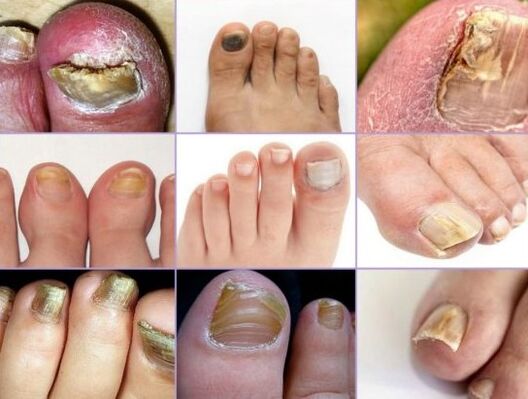
Célandine and tea wood oils - Mix these products in an equal proportion, dip the gauze bandage with the resulting composition and apply them to nails for 20 consecutive days for 45 minutes. The recipe is contraindicated in pregnant women.SODA - Dilute the soda with a small amount of water at the consistency of the porridge. Apply it on the nails for 20 minutes, then rinse with lukewarm water for 10 to 12 days twice a day. Apple vinegar - Dilute it with olive oil. The required proportion is 2 parts of vinegar to 1 part of the oil. Apply the mixture to the affected nail plates while the nail develops completely.Tea shaft oil - Apply a few drops of oil to the nails, while the areas of the nail plate affected by the fungus develop completely.Verba - Make 500 g of shoots from a young willow, pour 2 liters of water, bring to a boil. Decoction finished three times a week, make baths for the hands or legs for 20 minutes until recovery.Nettle - Brass 3 tablespoons of nettles in 400 ml of water. With this decoction, get wet pads and apply them on the nail plates twice a day before recovery.Crush the leaves of the mountain ashs and put the nails with a thick layer, then wrap it with a cooking film for 30 minutes. Repeat the procedure daily 12-14 days.The fungus of the skin of the feet.Reducing immunity.Family members suffering from fungal defeat.Age of the elderly.Diabetes.The presence of microtraumas and burrs.Increase in leg sweating.Unknown and poor shoes.The habit of walking barefoot in public places.Accommodation and work in a damp climate.Wearing artificial nails in the long term.General health.Sensitivity to infection.The humidity and thermal background level.The type of nail plate (the nails on the fingers grow more slowly).Distal underwater onychomycosis.Lateral onychomycosis.White surface onychomycosis.Onychomycosis of the proximal tray.Total dystrophic onychomycosis.How can you get an infection with a fungus?Infection by nail yeast infection can occur anywhere: from places of public visit to your own house. It is transmitted directly to people to people, as well as by objects with whom a person suffering from mycosis has contacted. The fungus penetrates through the microfissances, bruises, other damage.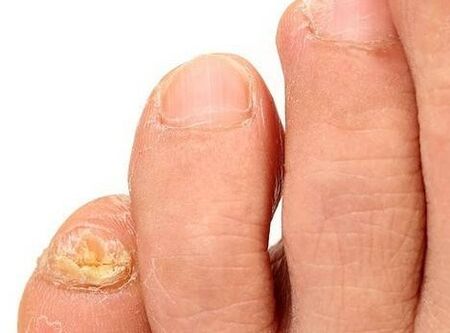
Places in which you can be infected with mycosis:Public places where people often go barefoot, especially if humidity increases. In such a microclimate, Mikoz keeps life for a long time. Examples of these institutions are souls in fitness centers, saunas, baths.Drosses in stores, sports complexes and other places.Manicure rooms - If the master does not treat the tools badly after having manicure or a pedicure to a person with a fungus, there is a very great probability that the next customer will be infected with this disease.Visit and at home - when a person puts clothes, shoes where the mushroom has remained, uses a towel that he had previously used by onychomycosis. The fungus can be on the nails if you walk barefoot on the floor.PLAG - In the sand on the beach, there are always a lot of mushroom conflicts. If you are walking barefoot, they will enter microcoffs and diseases cannot be avoided. In addition, you can be infected on the beach through a sunbed.Public transport - through running hands, to which the patient touched.Boutique - While trying the bare foot of shoes, which previously measured the patient with a fungus of nail.There is a good chance of being infected with a fungus of nails in public transportIn the above places, you should be extremely treated to avoid infection.


How can you get an infection with a fungus?Infection by nail yeast infection can occur anywhere: from places of public visit to your own house. It is transmitted directly to people to people, as well as by objects with whom a person suffering from mycosis has contacted. The fungus penetrates through the microfissances, bruises, other damage.
Places in which you can be infected with mycosis:Public places where people often go barefoot, especially if humidity increases. In such a microclimate, Mikoz keeps life for a long time. Examples of these institutions are souls in fitness centers, saunas, baths.Drosses in stores, sports complexes and other places.Manicure rooms - If the master does not treat the tools badly after having manicure or a pedicure to a person with a fungus, there is a very great probability that the next customer will be infected with this disease.Visit and at home - when a person puts clothes, shoes where the mushroom has remained, uses a towel that he had previously used by onychomycosis. The fungus can be on the nails if you walk barefoot on the floor.PLAG - In the sand on the beach, there are always a lot of mushroom conflicts. If you are walking barefoot, they will enter microcoffs and diseases cannot be avoided. In addition, you can be infected on the beach through a sunbed.Public transport - through running hands, to which the patient touched.Boutique - While trying the bare foot of shoes, which previously measured the patient with a fungus of nail.There is a good chance of being infected with a fungus of nails in public transportIn the above places, you should be extremely treated to avoid infection.



















